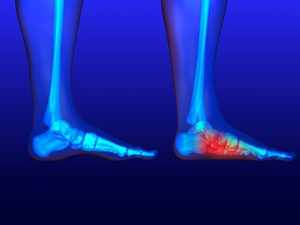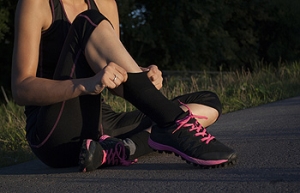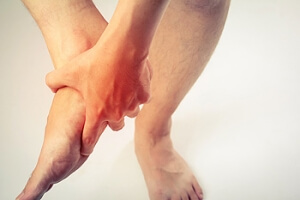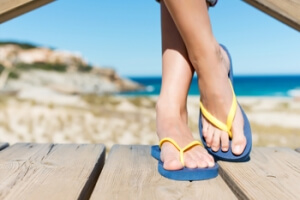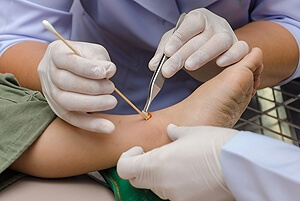
Stretching Your Feet
Debilitating foot pain is a problem for many people. But just as stretching the torso can help alleviate back pain, stretching the feet can also help mend existing foot problems and prevent future ones.
The feet, as the body’s foundation, carry the body’s entire weight and can get easily strained from overexertion. Persistent sharp pain and cramping in the feet are often common concerns. Foot pain and foot problems can be due to any number of causes, and in many cases pain may be eased without medication or doctor visits. It is always a good idea, however, to first rule out any serious medical issues with a physician.
Stretching can help relax the feet and alleviate pain, but is especially important before heavy aerobic exercise. Stretching before such activities can help you avoid experiencing painful cramps or strained foot muscles. Stretches should be performed slowly and deliberately without forceful pulling. The stretch should be held for several seconds before relaxing.
A great way to stretch out and loosen up the foot muscles while sitting is to cross one leg over the other and pull the toes carefully back without overextending. Start by resting the left ankle on the right knee. With the left hand, gently flex the left foot by pulling back on the toes. Do not pull too hard; just hard enough to feel the stretch in the arch of the foot. Then point the toes of the left foot as far as you can. Rotate the motion of pointing with pulling back on the toes. This should relax and stretch the muscles on the bottom and the top of the foot. Doing this stretch ten to twenty times should bring relief. Repeat the whole process for the other foot by resting the right ankle on the left knee.
A stretch that focuses on the often injured Achilles tendon involves standing and facing a wall with your arms out and hands flat against the wall. Step back with one foot, keeping it flat against the floor. Move the other leg forward and lean toward the wall. You should feel a stretch through the back of your leg and your Achilles tendon, but do not push yourself too much. Stop when you feel a stretching sensation, and hold for 30 seconds. Ten repetitions may be done for each foot.
Stretching the feet is important for athletes or those performing aerobic exercise, but it can also help anyone with foot pain caused by poor footwear, plantar fasciitis, or long hours standing and walking. Individuals who tend to their feet by regularly stretching every day should be able to minimize foot pain and prevent new problems from arising.
Babies, Children, and Flat Feet
 “Pes Planus” is the medical term for the foot condition known as flat feet. It can also be referred to as fallen arches and is noticeable while standing on the floor. Many babies are born with flat feet, and the arch will typically develop by the age of six. Some children have calf muscles that are inflexible, and this may affect arch development as well. Mild relief may be found when proper shoes are worn, and it may help to perform specific foot stretches. If the muscles in the feet are weak, it may be beneficial to walk on varied surfaces that can consist of grass and sand. If your child has not developed arches in their feet, it is strongly advised that you seek the counsel of a podiatrist who can determine what the best course of treatment is.
“Pes Planus” is the medical term for the foot condition known as flat feet. It can also be referred to as fallen arches and is noticeable while standing on the floor. Many babies are born with flat feet, and the arch will typically develop by the age of six. Some children have calf muscles that are inflexible, and this may affect arch development as well. Mild relief may be found when proper shoes are worn, and it may help to perform specific foot stretches. If the muscles in the feet are weak, it may be beneficial to walk on varied surfaces that can consist of grass and sand. If your child has not developed arches in their feet, it is strongly advised that you seek the counsel of a podiatrist who can determine what the best course of treatment is.
Flatfoot is a condition many people suffer from. If you have flat feet, contact one of our podiatrists from Podiatry Associates of Texas. Our doctors will treat your foot and ankle needs.
What Are Flat Feet?
Flatfoot is a condition in which the arch of the foot is depressed and the sole of the foot is almost completely in contact with the ground. About 20-30% of the population generally has flat feet because their arches never formed during growth.
Conditions & Problems:
Having flat feet makes it difficult to run or walk because of the stress placed on the ankles.
Alignment – The general alignment of your legs can be disrupted, because the ankles move inward which can cause major discomfort.
Knees – If you have complications with your knees, flat feet can be a contributor to arthritis in that area.
Symptoms
- Pain around the heel or arch area
- Trouble standing on the tip toe
- Swelling around the inside of the ankle
- Flat look to one or both feet
- Having your shoes feel uneven when worn
Treatment
If you are experiencing pain and stress on the foot you may weaken the posterior tibial tendon, which runs around the inside of the ankle.
If you have any questions please feel free to contact our offices located in Arlington Weatherford, Mineral Wells, and Farmers Branch, TX . We offer the newest diagnostic and treatment technologies for all your foot and ankle needs.
Flat Feet
Flatfoot is a foot condition in which the arch of the foot has either partially or totally dropped or has never developed. While it is common in babies and small children, it can become a problem for them in adulthood if the arch never forms. For adults, the development of flat feet can be brought upon by injury, as a result of pregnancy due to increased elasticity, or obesity. Those who have health concerns such as rheumatoid arthritis or diabetes may also be at greater risk for developing the condition.
If you suspect that you have flat feet, it is best to consult your podiatrist. Your foot doctor will examine the suspected foot and observe how it looks while you sit and stand. He or she may take an X-ray to determine how serious the condition is. Some common signs of flatfoot include toe drift, in which the toes and front part of the foot point outward, a short Achilles tendon, and a heel that tilts outwardly while the ankle tilts inward.
Once flatfoot has been diagnosed, your podiatrist may suggest one of several treatment options. Flat feet can be rigid, in which the feet appear to have no arch even when the person is not standing; or flexible, in which the person appears to have an arch while not standing, but once standing the arch disappears. Those with flexible flatfoot may be told to reduce any activities that cause pain and to avoid extended periods of walking or standing. Another suggestion may be weight loss, as excessive weight may be placing pressure on the arches
In few cases, if the condition is severe and all other methods have been exhausted surgery may be required. This is normally avoided, however, due to a lengthy recovery time and high cost.
Differences in Heel Size
 The feet are considered to be the foundation of the body, and it is important to wear the right shoes for your chosen sport. The main differences between walking and running shoes is the amount of flexibility and stability. The heel is constructed differently in running shoes, and appears to be wider than in walking shoes. Additionally, it is beneficial to have the feet professionally measured, as this is helpful in determining what the correct size shoe is. If you would like more information about the differences between walking and running shoes, please speak to a podiatrist.
The feet are considered to be the foundation of the body, and it is important to wear the right shoes for your chosen sport. The main differences between walking and running shoes is the amount of flexibility and stability. The heel is constructed differently in running shoes, and appears to be wider than in walking shoes. Additionally, it is beneficial to have the feet professionally measured, as this is helpful in determining what the correct size shoe is. If you would like more information about the differences between walking and running shoes, please speak to a podiatrist.
For more information about walking shoes versus running shoes, consult with one of our podiatrists from Podiatry Associates of Texas. Our doctors can measure your feet to determine what your needs are and help you find an appropriate pair of footwear.
Foot Health: The Differences between Walking & Running Shoes
There are great ways to stay in shape: running and walking are two great exercises to a healthy lifestyle. It is important to know that running shoes and walking shoes are not interchangeable. There is a key difference on how the feet hit the ground when someone is running or walking. This is why one should be aware that a shoe is designed differently for each activity.
You may be asking yourself what the real differences are between walking and running shoes and the answers may shock you.
Differences
Walking doesn’t involve as much stress or impact on the feet as running does. However, this doesn’t mean that you should be any less prepared. When you’re walking, you land on your heels and have your foot roll forward. This rolling motion requires additional support to the feet.
Flexibility – Walking shoes are designed to have soft, flexible soles. This allows the walker to push off easily with each step.
If you have any questions, please feel free to contact our offices located in Arlington Weatherford, Mineral Wells, and Farmers Branch, TX . We offer the newest diagnostic and treatment technologies for all your foot care needs.
Differences between Walking and Running Shoes
Both running and walking are great exercises, but should a person wear the same shoes for both activities? The answer is no, because there is a difference between the way a person’s feet hit the ground when they are walking and when they are running. Therefore, the shoes for each activity are designed differently. Before you begin any exercise program it is always recommended that you speak with your doctor or podiatrist.
Walking is a low impact exercise that is often recommended by doctors to their patients. While walking is a simple activity, it still requires some degree of preparation. If you think about walking and how your feet strike the ground as you move, you will notice that your heel hits the ground first before your foot continues to roll forward and your next step begins. Because of this rolling motion, walking shoes are designed to be more flexible than running shoes. This flexibility helps the walker push off with each step taken.
Because the heel hits the ground first when you walk, walking shoes are designed to absorb most of the shock. Walking shoes should therefore have a beveled or angled heel. The angle of the heel helps absorb the shock and reduces pressure from the ankles. This is especially important for speed walkers, as their feet will hit the ground twice as often as the normal walker.
When people decide to run as a hobby or for their health, they must first realize that running is a high impact exercise. If not done with the proper equipment, running may cause damage to the feet and legs. Running shoes are designed to be more lightweight and to have thicker soles. The thicker soles act as shock absorbers for the rest of the body. Walking shoes often do not have the proper arch support that running shoes do.
A proper fitting shoe can make or break a runner or a walker. If the shoes are too big, their feet will slide back and forth inside the shoe and cause blisters. Whether you will be running or walking, the right equipment can make all of the difference in the world.
Can Stretches Help to Relieve Foot Pain?
 The common areas for foot pain to occur is the arch, the plantar fascia, and the forefoot. Foot pain may originate from the calf muscles or a tight Achilles tendon, and there are several methods that can be implemented that may help to loosen muscles in this area. Many patients find that when they roll a golf ball or rolling pin under the sole of their foot, their pain is relieved. This can be beneficial in releasing tension in the feet. The arch can gain strength by keeping the feet flat on the floor, and lifting the foot while making sure the big toe remains on the ground. Additionally, the overall foot may benefit when towel curls are performed, and this is practiced by scrunching a towel placed on the floor and picking it up with the toes. If you would like more information about stretches that can be performed for specific foot pain, please consult with a podiatrist.
The common areas for foot pain to occur is the arch, the plantar fascia, and the forefoot. Foot pain may originate from the calf muscles or a tight Achilles tendon, and there are several methods that can be implemented that may help to loosen muscles in this area. Many patients find that when they roll a golf ball or rolling pin under the sole of their foot, their pain is relieved. This can be beneficial in releasing tension in the feet. The arch can gain strength by keeping the feet flat on the floor, and lifting the foot while making sure the big toe remains on the ground. Additionally, the overall foot may benefit when towel curls are performed, and this is practiced by scrunching a towel placed on the floor and picking it up with the toes. If you would like more information about stretches that can be performed for specific foot pain, please consult with a podiatrist.
Foot Pain
Foot pain can be extremely painful and debilitating. If you have a foot pain, consult with one of our podiatrists from Podiatry Associates of Texas. Our doctors will assess your condition and provide you with quality foot and ankle treatment.
Causes
Foot pain is a very broad condition that could be caused by one or more ailments. The most common include:
- Bunions
- Hammertoes
- Plantar Fasciitis
- Bone Spurs
- Corns
- Tarsal Tunnel Syndrome
- Ingrown Toenails
- Arthritis (such as Gout, Rheumatoid, and Osteoarthritis)
- Flat Feet
- Injury (from stress fractures, broken toe, foot, ankle, Achilles tendon ruptures, and sprains)
- And more
Diagnosis
To figure out the cause of foot pain, podiatrists utilize several different methods. This can range from simple visual inspections and sensation tests to X-rays and MRI scans. Prior medical history, family medical history, and any recent physical traumatic events will all be taken into consideration for a proper diagnosis.
Treatment
Treatment depends upon the cause of the foot pain. Whether it is resting, staying off the foot, or having surgery; podiatrists have a number of treatment options available for foot pain.
If you have any questions, please feel free to contact our offices located in Arlington Weatherford, Mineral Wells, and Farmers Branch, TX . We offer the newest diagnostic and treatment technologies for all your foot care needs.
Foot Pain
The feet, being the foundation of the body, carry all of the body’s weight and are therefore prone to experiencing pain and discomfort. If you are experiencing foot pain, it is important to determine where in the foot you are experiencing this pain to help discover the cause of it. While pain can be experienced virtually anywhere in the foot, the most common sites of foot pain are in the heel and ankle.
Heel pain can be due to a multitude of conditions including plantar fasciitis, Achilles tendinitis, and heel spurs. Pain experienced in the ankle can be a sign of an ankle sprain, arthritis, gout, ankle instability, ankle fracture, or nerve compression. In more serious cases, pain in the foot can be a sign of improper alignment or an infection.
Foot pain can be accompanied by symptoms including redness, swelling, stiffness and warmth in the affected area. Whether the pain can be described as sharp or dull depends on the foot condition behind it. It is important to visit your local podiatrist if your foot pain and its accompanying symptoms persist and do not improve over time.
Depending on the location and condition of your foot pain, your podiatrist may prescribe certain treatments. These treatments can include but are not limited to prescription or over-the-counter drugs and medications, certain therapies, cortisone injections, or surgery.
If you are experiencing persistent foot pain, it is important to consult with your foot and ankle doctor to determine the cause and location. He or she will then prescribe the best treatment for you. While milder cases of foot pain may respond well to rest and at-home treatments, more serious cases may take some time to fully recover.
The Best Places to Wear Flip Flops
 People who like flip flops generally enjoy their simplicity. They are simple to slip into, and are inexpensive to purchase. Despite these types of benefits, these shoes may not be the best shoe to wear. This is for several reasons, including the fact that most flip flops offer little or no arch support, weaken the foot muscles as a result of them needing to hold the shoe on the foot, and strain the Achilles tendon. Additionally, wearing flip flops may make it easier to fall, and the toes may become bruised. It is beneficial to wear flip flops to the pool, beach, and shower areas, but your overall foot health may benefit from limiting the time that your feet spend in flip flops. If you would like more information about the dangers of wearing this type of shoe, please consult with a podiatrist.
People who like flip flops generally enjoy their simplicity. They are simple to slip into, and are inexpensive to purchase. Despite these types of benefits, these shoes may not be the best shoe to wear. This is for several reasons, including the fact that most flip flops offer little or no arch support, weaken the foot muscles as a result of them needing to hold the shoe on the foot, and strain the Achilles tendon. Additionally, wearing flip flops may make it easier to fall, and the toes may become bruised. It is beneficial to wear flip flops to the pool, beach, and shower areas, but your overall foot health may benefit from limiting the time that your feet spend in flip flops. If you would like more information about the dangers of wearing this type of shoe, please consult with a podiatrist.
Flip-flops are not always the best choice of footwear. If you have any concerns about your feet or ankles, contact one of our podiatrists from Podiatry Associates of Texas. Our doctors will assist you with all of your foot and ankle needs.
Flip-Flops and Feet
When the weather starts warming up, people enjoy wearing flip-flops. Flip-flops are comfortable, stylish, and easy to slip on and off; they're perfect for any summer beach goer. However, these shoes can cause harm to the feet.
How Can Flip-Flops Affect Me Long-Term?
- Ankle problems
- Hip problems
- Lower back problems
- Pain in the balls of the feet
- Problems with foot arches
- Changes in the way you walk
Are There Injuries Associated with Flip-Flops?
Yes. Since flip-flops are relatively weak and do not provide the same amount of support as sneakers, people who wear flip-flops regularly are more susceptible to injuries. On top of that, the open nature of the shoe makes your feet more prone to other problems, such as cuts and even infections. Common injuries and ailments include:
- Sprained ankles
- Blisters
- Infections
- Cuts and Scrapes
I like Wearing Flip-Flops. Are There Safe Alternatives?
When buying flip-flops, try to find ones that have sturdy soles and that are made of high-quality materials that will support for your feet. These flip-flops will cost more but will also last longer as a result.
If you have any questions please feel free to contact our offices located in Arlington Weatherford, Mineral Wells, and Farmers Branch, TX . We offer the newest diagnostic and treatment technologies for all your foot and ankle needs.
Flipping Out About Flip Flops
Although it may be tempting to wear flip-flops in warm weather, they are not the best choice of footwear for your feet. Flip-flops may be ideal for the beach, pool, spa, and shared showers, but you should avoid wearing them unless it is completely necessary.
Flip-flops only have a small strip of fabric holding your foot in place, but your toes need a better grip to keep your foot in place. The repetitive gripping can lead to an overuse of your muscles, which could result in tendinitis. This is only one of the many problems that stem from wearing flip-flops too often.
Flip flops aren’t good for extensive walking because they fail to offer arch support, heel cushioning, or shock absorption. As a result, people who wear flip flops are at a higher risk of experiencing an ankle sprain. Additionally, these shoes offer little protection for your feet, putting those who wear them at a greater risk for stubbed toes, glass cuts, and puncture wounds.
Although flip flops aren’t recommended for everyday use by anyone, it is especially important for diabetics to avoid them. A diabetic foot injury can easily become very serious, and it may even lead to amputation.
If you are experiencing pain from wearing flip-flops, you shouldn’t be hesitant to replace them with a more comfortable shoe that offers more support. If your flip-flop foot pain doesn’t go away, you should seek assistance from a podiatrist right away. It is possible that you may have a more serious foot problem such as a stress fracture or arthritis.
What are Foot Ulcers?
 Foot ulcers are open sores located on the foot. They can vary in severity from shallow ulcers that affect only the surface level of skin, to deep ulcers that extend through the entire thickness of the skin and involve tendons and other deep structures. People who have diabetes or poor circulation are said to be more likely to develop foot ulcers. It is important to seek treatment for foot ulcers immediately, as diabetes and poor circulation can make ulcers very slow to heal, therefore, increasing the risk of infection. Infected ulcers can progress and lead to the formation of an abscess, infections of the skin and underlying fat, bone infections, and even gangrene. Fortunately, foot ulcers can be prevented and treated. If you have developed a foot ulcer, it is suggested that you are under the care of a podiatrist.
Foot ulcers are open sores located on the foot. They can vary in severity from shallow ulcers that affect only the surface level of skin, to deep ulcers that extend through the entire thickness of the skin and involve tendons and other deep structures. People who have diabetes or poor circulation are said to be more likely to develop foot ulcers. It is important to seek treatment for foot ulcers immediately, as diabetes and poor circulation can make ulcers very slow to heal, therefore, increasing the risk of infection. Infected ulcers can progress and lead to the formation of an abscess, infections of the skin and underlying fat, bone infections, and even gangrene. Fortunately, foot ulcers can be prevented and treated. If you have developed a foot ulcer, it is suggested that you are under the care of a podiatrist.
Wound care is an important part in dealing with diabetes. If you have diabetes and a foot wound or would like more information about wound care for diabetics, consult with one of our podiatrists from Podiatry Associates of Texas. Our doctors will assess your condition and provide you with quality foot and ankle treatment.
What Is Wound Care?
Wound care is the practice of taking proper care of a wound. This can range from the smallest to the largest of wounds. While everyone can benefit from proper wound care, it is much more important for diabetics. Diabetics often suffer from poor blood circulation which causes wounds to heal much slower than they would in a non-diabetic.
What Is the Importance of Wound Care?
While it may not seem apparent with small ulcers on the foot, for diabetics, any size ulcer can become infected. Diabetics often also suffer from neuropathy, or nerve loss. This means they might not even feel when they have an ulcer on their foot. If the wound becomes severely infected, amputation may be necessary. Therefore, it is of the upmost importance to properly care for any and all foot wounds.
How to Care for Wounds
The best way to care for foot wounds is to prevent them. For diabetics, this means daily inspections of the feet for any signs of abnormalities or ulcers. It is also recommended to see a podiatrist several times a year for a foot inspection. If you do have an ulcer, run the wound under water to clear dirt from the wound; then apply antibiotic ointment to the wound and cover with a bandage. Bandages should be changed daily and keeping pressure off the wound is smart. It is advised to see a podiatrist, who can keep an eye on it.
If you have any questions, please feel free to contact our offices located in Arlington Weatherford, Mineral Wells, and Farmers Branch, TX . We offer the newest diagnostic and treatment technologies for all your foot care needs.
